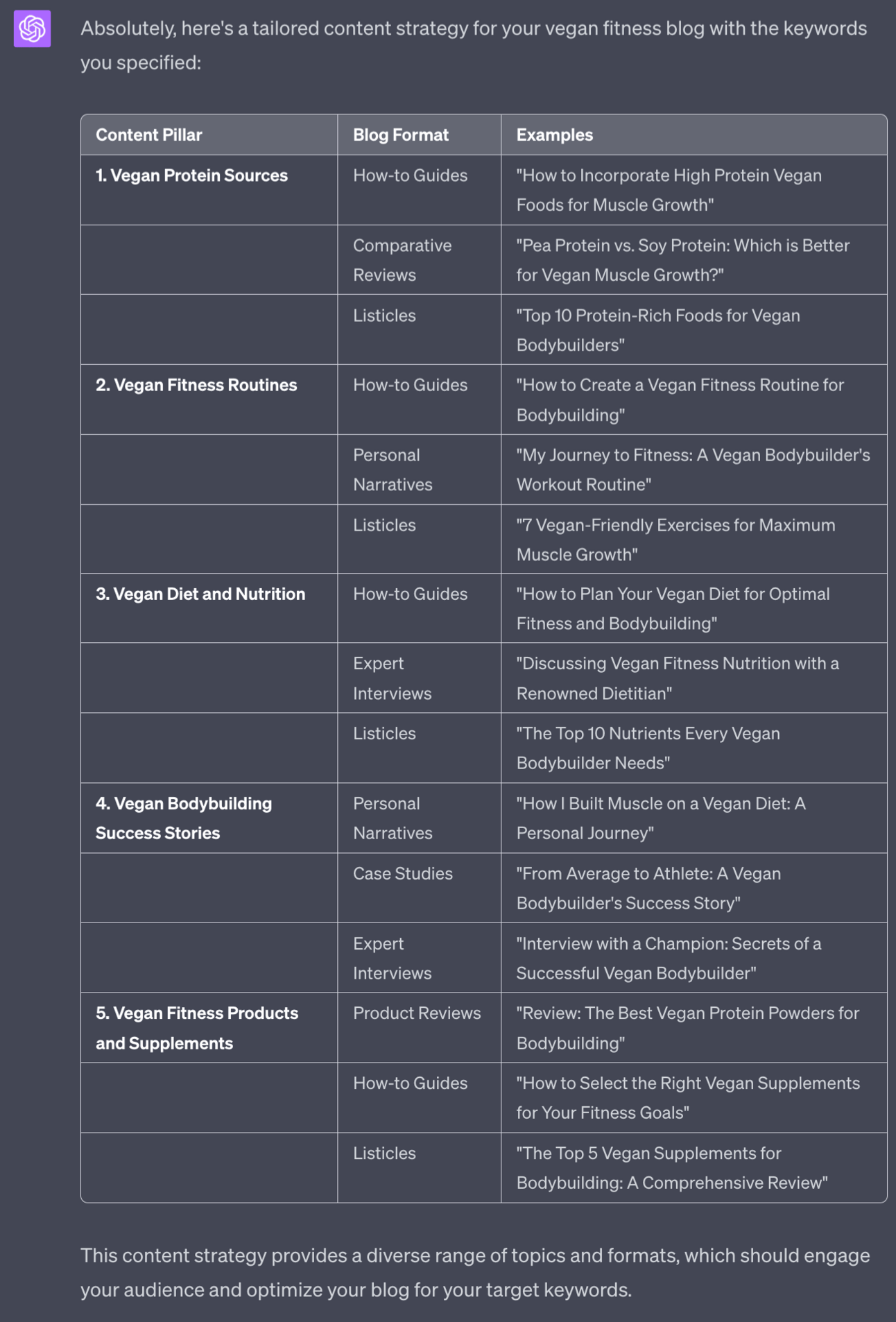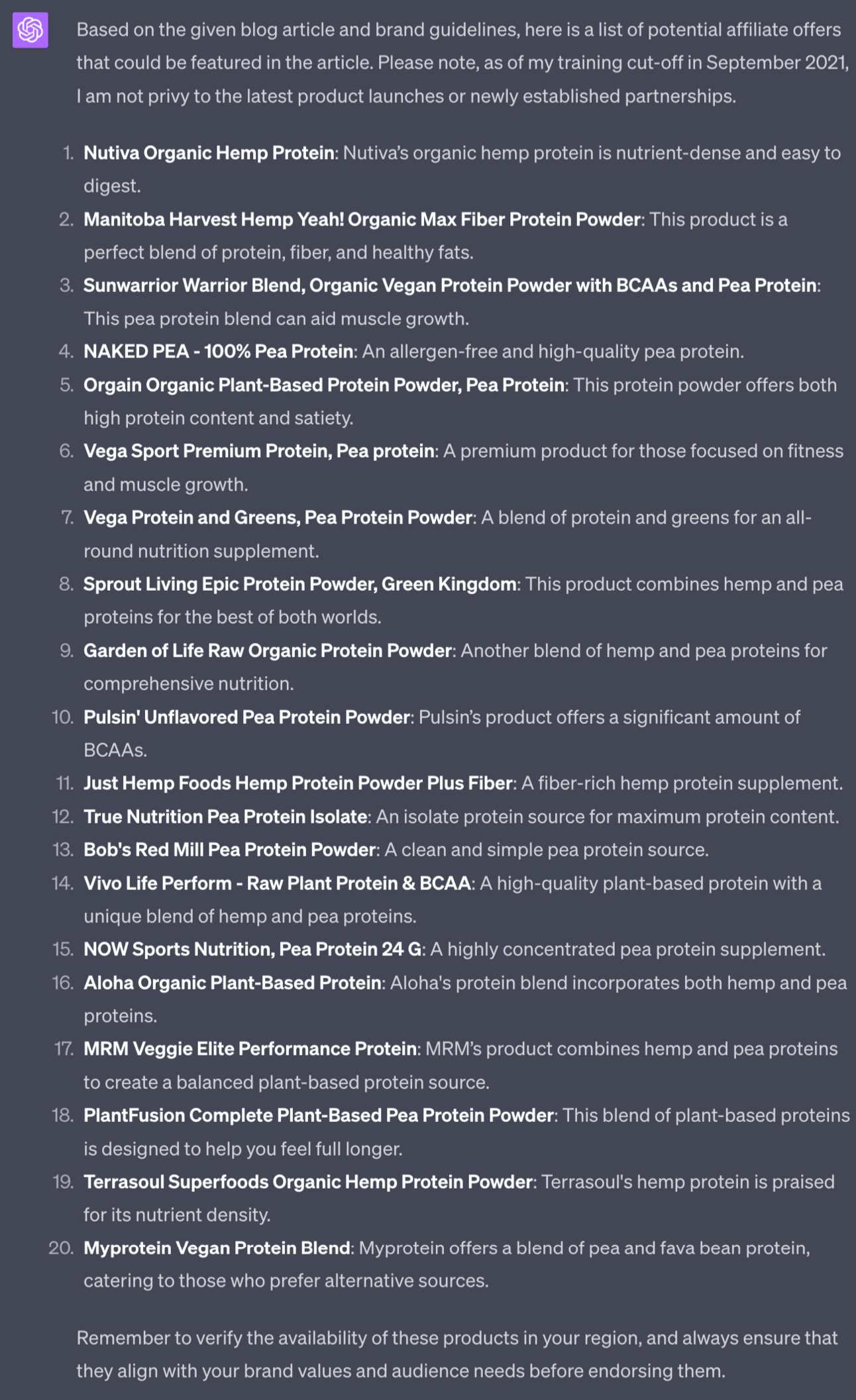Let’s get started:
Content Creation with ChatGPT.
1. Develop a Content Strategy
First up we’re going to have ChatGPT help work out our high level content strategy.
We’re borrowing an SEO concept called content pillars: in short having a range of content all grouped into categories.
We’re then asking for blog types within these pillars: for instance reviews, testimonials, expert advice.
Here’s the prompt:
Act as a affiliate marketing expert.
Help me to design a content strategy for my affiliate marketing blog.
The category is [niche]
My keywords are [copy/paste keywords]
Provide 5 content pillars
Provide 3 blog formats per content pillar, each should be text, no video or image based content
Give examples of each of the content types for each of the 5 content pillars for a total of 15 content pillar/format combinations
Take into account these brand guidelines in your response
#begin brand guidelines#
[copy/paste brand guidelines]
#end brand guidelines# Provide everything in tabular format
Plug in your niche and top keywords to customise the prompt to your needs.
Also drop in your brand guidelines to help ChatGPT modify suggestions. For instance if your brand is focused on ethical consumption and organic goods this will be added into your content strategy.
Prompt Output 💬

As always if any content pillar or blog format doesn’t interest you ask ChatGPT to make the appropriate changes.
When happy we’ll be using this strategy in the next step.
2. Article Title Brainstorm
Armed with our content strategy we’re now going to have ChatGPT come up with blog titles.
The blog titles are the first step in SEO and generating traffic – the titles will be the starting point for the actual blog articles themselves. So we need great blog titles first and foremost.
As an affiliate marketing expert use the provide content strategy to generate blog titles for my affiliate blog
My blog is focused on [niche]
My top keywords are [top keywords]
I will provide you with a content strategy which contains 5 Content pillars, each of which has 3 blog formats for a total of 15 combinations.
For each of the combinations generate 20 potential SEO optimised and clickable blog titles. Keep each title between 50-60 characters optimally.
Provide results in list format.
#content strategy begins#
[copy/paste content strategy]
#content strategy ends#
Prompt Output 💬
This prompt is going to kick out a LOT of information.
300 blog titles in fact.
Here’s the output for just one of the content pillars:

This is 20 blog titles per format type. And there are 3 format types per content pillar. For a total of 300 blog article titles.
This is going to give you and extremely wide range of coverage for SEO and will lead to interesting and readable content.
We could have just asked for 300 blog articles about one topic – that might be good for Google SEO.
But imagine how boring that blog is going to be for actual human readers. Very!
So instead we are building up an interesting base of content pillars and format types for variety.
We’re now going to take these blog titles into blog creation.
3. Blog post creation
First up – the elephant in the room. SEO and AI.
Lots of people say that AI content will not work for SEO because Google will eventually deprioritise it and stop showing it to visitors.
This is true.
If I just went into ChatGPT and said “write me a blog post on vegan protein sources”. ChatGPT would create something generic that sounds very “AI”.
Try it now! The results will be rubbish.
But what we’ve been doing up, through these multiple steps, is building up material so that our blog posts will be unique and undetectable as AI generated.
We started in Part 1 with keyword research and choosing our niche. In Part 2 we built on this with a name and brand guidelines, which were built on Part 1.
We’ve now folded all of this information from Part 1 and 2 into today’s work – our content strategy and blog titles are based on the brand guidelines which in turn are based on prior work!
See what we’ve been doing? Each time we build on past work we’re making the results more and more unique. This is why it’s important to go step by step, always using outputs from the previous work in new prompts.
Now we’re going to use all of this to generate unique, interesting and undetectable SEO optimised articles.
Here’s the prompt:
Act as a SEO blog writer.
Write a 750-1000 word SEO optimised blog article with the title : [title]. Optimise the article for keyphrases in the title.
This is a [blog format] article
Use the AIDA writing framework
Use subheadings, bullet points and make suggestions for images when appropriate
Implement the following brand guidelines, paying special attention to the tone of voice
#brand guidlines begin#
[copy/paste brand guidelines]
#brand guidelines end#
Prompt Output 💬
This will kick out an entire blog article for you. Here it is, apologies for the size!

This article will include all of your previous work, which makes it much more undetectable as AI written.
However, it’s still good practice to take you article over to https://contentatscale.ai/ai-content-detector/ to run a check.
This will show you parts of the article that seem to be AI written. Delete or rewrite these parts. If possible make use this manual edit to really add some human spin.
For example in this article “The answer isn’t one-size-fits-all” was flagged up as likely to be AI generated. So I switched it out to “Sadly, it ain’t that easy!” which passed with flying colours.
Even if you need to do a little manual tidying you’ve still got the bulk of the work done in seconds rather than hours.
Or you’ve saved yourself having to hire a writer to prepare the article for you. A 750 word blog article on Fiverr is $20+ so 300 articles like this would cost you $6000. Oof.
Instead on your side you need to simple swap out the title and generate more.
Now that you’ve seen how to generate articles en-masse let’s loop to the affiliate products we’re going to promote.
4. Suggest Affiliate Products
You might be wondering why we’ve left this so late.
There’s a reason: we want to focus on making good content first.
If we instead find the affiliate products first there’s a temptation just to write about the affiliate products.
But guess what…that’s what every other affiliate marketer is doing.
Instead we’re going to build a solid base of quality content on a range of subjects. Make the blog genuinely useful. And then plug in relevant affiliate offers.
Here’s the prompt:
Act as an affiliate marketing specialist.
I will provide you with a blog article and with brand guidelines
Based on both of these please provide me with a list of 20 potential affiliate offers options I could feature in the article. I will feature one offer but provide me with options so I may choose.
#blog article begins#
[copy/paste blog article]
#blog article ends# #brand guidelines begins#
[copy/paste brand guidelines]
#brand guidelines ends#
Prompt Output 💬

This spits out 20x potential affiliate offers.
I’ve not asked the prompt to give direct links. This is because ChatGPT tends to make up links when it doesn’t know.
Instead use this to Google the product along with the word “affiliate” to find the affiliate sign up page.
Most products will also simply be on Amazon. If that’s the case you can just recommend the Amazon listing via Amazon Associates. Simple.
Seems like lots of work? Yes and no. Once you’ve done this process a few times with your first blog articles you’’ start to know the affiliate landscape for your niche.
And then you can simple recommend the same products in multiple blog articles. This prompt is therefore primarily to get you started.
5. Weave Affiliate Links into Blog Post
Once you’ve chosen the product from the list use this prompt (in the same window) to close out the article.
Act as an affiliate marketing blog writer.
Take the blog article from above and weave in a product recommendation for [chosen product] where appropriate
make the recommendation subtle and part of the flow of the articlePrompt Output 💬

This will take the product that you’ve recommended and adjust the original article to fit it in naturally.
Notice that we went from blog article to product back to article.
The content came before the sale. This ensures a higher quality affiliate marketing blog than your competitors.
In your blogging platform simple turn Bob’s Red Mill Pea Protein Powder into a link and insert your affiliate link. Done.
Pulling it together
OK we’ve broken the back of the process!
Today was the meat and potatoes of SEO : creating content, en masse, to drive traffic.
Now that we have a process in place to create this content you need to set yourself a target output and keep producing.
More is better. Always. But set a sustainable target for yourself moving forward.
Tomorrow we’re going to move on to how to get the word out about your blog and start driving traffic to kickstart the SEO process.
